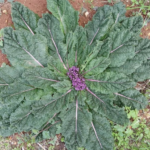Καλάδρωπος, Μηλοπιπονιά, Παπούτσα, Μανδραγόρας ο φαρμακευτικός
Etymology of Mandragora officinarum: The name of the genus derives from the Ancient Greek "μανδραγόρας" [mandragoras], of unknown etymology. The word could originate from the Old Persian "merdum gija", meaning "plant of humans", because the root of an aged Mandragora officinarum resembles a stooge. Actually, one of the names the folk used to call it in Cyprus was "καλάδρωπος", meaning "good human". Another possibility is that the plant was named after a doctor. "Officinarum" is New Latin and denotes a plant which was used as medicine or as a culinary herb. It means "of or belonging to an officina". The "officina" was the building in medieval monasteries where monks prepared medicine. It was often connected to the herb garden.
This is the only Mandragora species/kind that grows on its own in Cypriot nature.
Mandragora officinarum is an uncommon plant on the island. It is encountered up to an altitude of 600 metres in the perimeter of Cyprus excluding the Karpasia peninsula. It primarily grows on uncultivated, open, fertile land. Its flowering period is between December and April.
